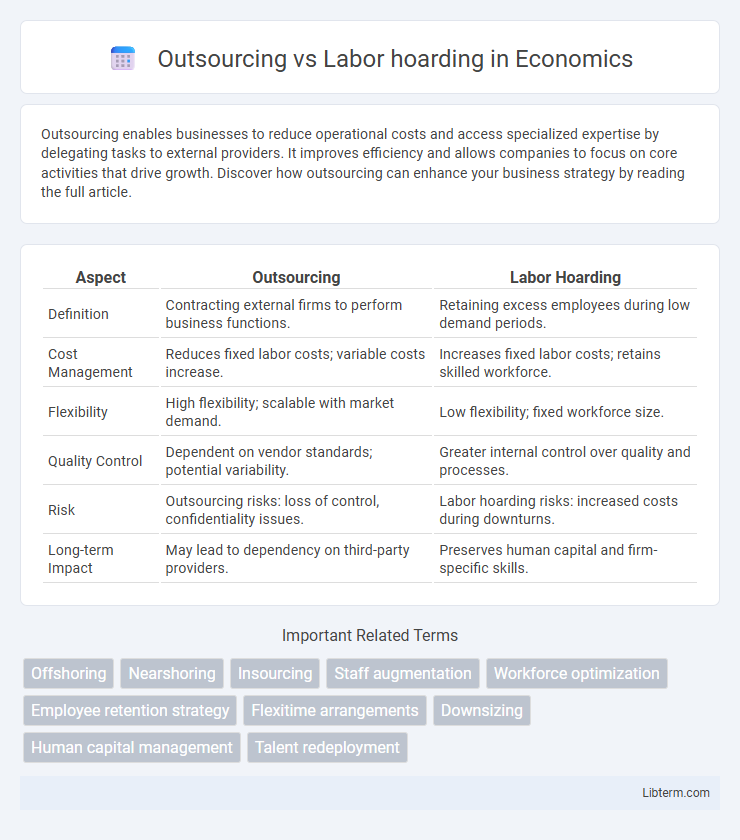Outsourcing enables businesses to reduce operational costs and access specialized expertise by delegating tasks to external providers. It improves efficiency and allows companies to focus on core activities that drive growth. Discover how outsourcing can enhance your business strategy by reading the full article.
Table of Comparison
| Aspect | Outsourcing | Labor Hoarding |
|---|---|---|
| Definition | Contracting external firms to perform business functions. | Retaining excess employees during low demand periods. |
| Cost Management | Reduces fixed labor costs; variable costs increase. | Increases fixed labor costs; retains skilled workforce. |
| Flexibility | High flexibility; scalable with market demand. | Low flexibility; fixed workforce size. |
| Quality Control | Dependent on vendor standards; potential variability. | Greater internal control over quality and processes. |
| Risk | Outsourcing risks: loss of control, confidentiality issues. | Labor hoarding risks: increased costs during downturns. |
| Long-term Impact | May lead to dependency on third-party providers. | Preserves human capital and firm-specific skills. |
Introduction to Outsourcing and Labor Hoarding
Outsourcing involves contracting external firms to handle specific business functions, enabling companies to reduce costs and access specialized skills. Labor hoarding, on the other hand, refers to retaining employees during economic downturns to preserve workforce knowledge and avoid future hiring costs. Both strategies reflect distinct approaches to managing labor resources in response to market fluctuations.
Defining Outsourcing: Key Concepts and Trends
Outsourcing involves contracting external organizations to perform business functions or services, enabling companies to focus on core competencies and reduce operational costs. Key concepts include strategic decision-making, cost efficiency, and access to specialized expertise, while recent trends emphasize digital transformation, cloud services, and global talent sourcing. This approach contrasts with labor hoarding, where firms retain excess internal workforce to preserve skills and reduce turnover risks during economic fluctuations.
Understanding Labor Hoarding: What Does It Mean?
Labor hoarding refers to a company's decision to retain more employees than needed during economic downturns, aiming to preserve skilled labor and avoid future rehiring costs. This practice contrasts with outsourcing, where tasks are delegated externally to reduce labor expenses and increase flexibility. Understanding labor hoarding involves recognizing its strategic benefit in maintaining workforce stability and readiness for market recovery.
Historical Context: Evolution of Workforce Strategies
Outsourcing and labor hoarding strategies have evolved significantly since the industrial revolution, reflecting shifts in economic demands and technological advancements. During the post-World War II era, labor hoarding was prevalent as companies aimed to retain skilled workers amid uncertain economic conditions, while the late 20th century saw a rise in outsourcing driven by globalization and cost reduction pressures. The 21st century continues to witness a dynamic balance, with digital transformation influencing firms to adopt hybrid workforce models combining outsourced services and retained internal labor.
Advantages and Disadvantages of Outsourcing
Outsourcing offers cost savings by leveraging specialized external providers, enhancing focus on core business activities and increasing operational flexibility. However, it may lead to reduced control over quality and processes, potential communication challenges, and risks related to data security and intellectual property. Balancing these advantages and disadvantages is crucial for businesses deciding between outsourcing and labor hoarding strategies.
Pros and Cons of Labor Hoarding
Labor hoarding preserves skilled employees during economic downturns, maintaining workforce stability and reducing rehiring and training costs when demand recovers. However, it can lead to increased labor costs and decreased productivity in low-demand periods, as employees may be underutilized or engaged in non-essential tasks. Balancing these factors is crucial for firms aiming to sustain human capital without compromising financial efficiency.
Economic Impact: Cost, Efficiency, and Flexibility
Outsourcing reduces operational costs by leveraging external expertise and competitive labor markets, enhancing business efficiency and operational flexibility. Labor hoarding increases short-term expenses due to maintaining surplus staff, but can preserve institutional knowledge and reduce future hiring costs, offering long-term stability. The economic impact varies based on industry dynamics, with outsourcing favoring cost reduction and agility, while labor hoarding supports resilience during market fluctuations.
Outsourcing vs Labor Hoarding: Industry-Specific Examples
Outsourcing enables companies in the technology and manufacturing sectors to reduce costs and increase flexibility by contracting external specialists, while labor hoarding is prevalent in industries like automotive and aviation, where firms retain employees to preserve skill sets and ensure rapid recovery during fluctuating demand. In retail, outsourcing customer service functions contrasts with labor hoarding in healthcare, where staff retention supports continuous patient care despite economic downturns. These industry-specific strategies reflect differing priorities: cost-efficiency and scalability through outsourcing, versus workforce stability and knowledge retention through labor hoarding.
Decision-Making Factors: When to Outsource or Hoard Labor
Decision-making factors for outsourcing versus labor hoarding revolve around cost efficiency, flexibility, and long-term strategic goals. Outsourcing becomes favorable when organizations seek to reduce direct labor costs, access specialized skills, and adapt quickly to fluctuating demand without increasing fixed overhead. Labor hoarding is strategically viable during economic uncertainty or industry downturns, preserving skilled workforce to maintain operational continuity and avoid retraining costs upon market recovery.
Future Outlook: Workforce Strategies in a Changing Economy
Outsourcing enables companies to remain agile by leveraging specialized external talent pools, reducing fixed labor costs amid economic uncertainty. Labor hoarding preserves institutional knowledge and workforce morale, positioning businesses to rapidly scale operations when market conditions improve. Future workforce strategies will likely blend these approaches, balancing cost-efficiency with talent retention to navigate evolving economic dynamics.
Outsourcing Infographic

 libterm.com
libterm.com